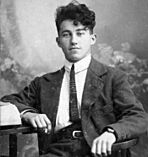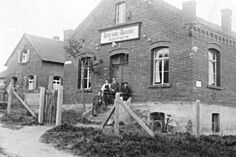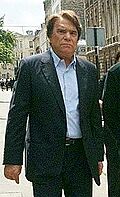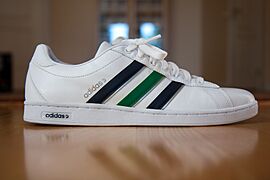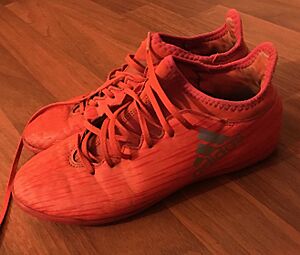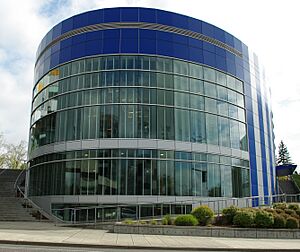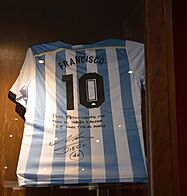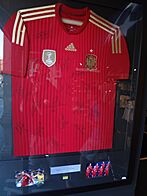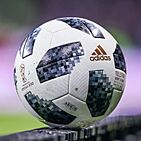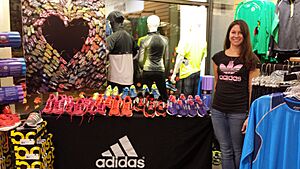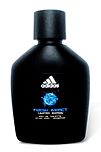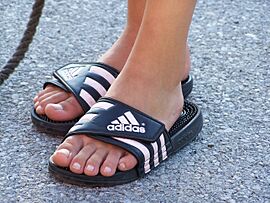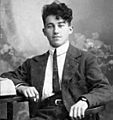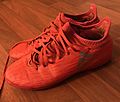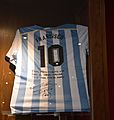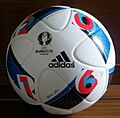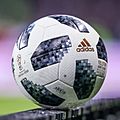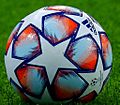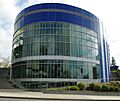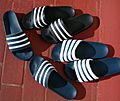Adidas facts for kids
 |
|
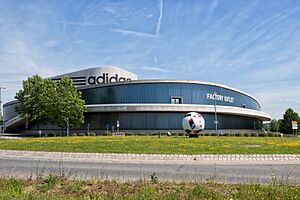
Factory outlet in Herzogenaurach, Germany
|
|
|
Formerly
|
Gebrüder Dassler Schuhfabrik (1924–1949) |
|---|---|
| Public | |
| Traded as | FWB: ADS DAX component |
| Industry | Textile, footwear |
| Founded | July 1924 in Herzogenaurach, Germany (as Gebrüder Dassler Schuhfabrik) 18 August 1949 (as Adidas) |
| Founder | Adolf Dassler |
| Headquarters |
Herzogenaurach, Bavaria
,
Germany
|
|
Area served
|
Worldwide |
|
Key people
|
|
| Products | Apparel, footwear, sportswear, sports equipment, toiletries |
| Revenue | |
|
Operating income
|
|
| Total assets | |
| Total equity | |
|
Number of employees
|
62,035 (2024) |
| Subsidiaries |
|
Adidas AG is a German company that makes sports clothes and shoes. Its main office is in Herzogenaurach, Germany. It is the biggest sportswear maker in Europe. It is also the second largest in the world, right after Nike. Adidas owns part of the football club Bayern Munich. It also owns Runtastic, a fitness technology company from Austria. In 2024, Adidas made about €23 billion in sales.
The company was started by Adolf Dassler in his mother's house. His older brother Rudolf joined him in 1924. They called their business "Dassler Brothers Shoe Factory." Adolf Dassler helped create running shoes with spikes. He changed them from heavy metal spikes to lighter ones made of canvas and rubber. At the 1936 Summer Olympics, Dassler convinced U.S. sprinter Jesse Owens to wear his handmade spiked shoes. In 1949, the brothers had a disagreement. Adolf started Adidas, and Rudolf started Puma. Puma then became Adidas's main business rival.
The three stripes are a famous symbol for Adidas. They have been used on the company's clothes and shoes for a long time. Adidas bought this design in 1952 from a Finnish sports company called Karhu Sports. They paid about €1,600 and two bottles of whiskey for it. The three stripes became so popular that Adolf Dassler called Adidas "The three stripes company."
Contents
The Story of Adidas
Early Days: The Dassler Brothers Shoe Factory
Adolf "Adi" Dassler started making sports shoes in his mother's laundry room. This was in Herzogenaurach, Germany, after he returned from World War I. In July 1924, his older brother Rudolf joined the business. They named it "Dassler Brothers Shoe Factory." Sometimes, the electricity in Herzogenaurach was not reliable. So, the brothers had to use a stationary bicycle to power their machines.
Adolf Dassler helped create spiked running shoes for many sports. He improved them by using canvas and rubber instead of heavy metal spikes. In 1936, Dassler convinced U.S. sprinter Jesse Owens to wear his handmade spikes. Owens won four gold medals at the 1936 Summer Olympics. After this, Dassler shoes became famous among athletes and coaches worldwide. The business was doing very well. The Dasslers were selling 200,000 pairs of shoes every year before World War II.
During the war, the factory made shoes for the German army. Later, it was used to make anti-tank weapons. In 1945, U.S. forces almost destroyed the factory. But Adolf Dassler's wife convinced the American soldiers that the company only wanted to make sports shoes. So, the factory was saved. After the war, American soldiers became big buyers of the Dassler brothers' shoes.
Brothers Separate: Adidas and Puma
The Dassler brothers had a big disagreement in 1947. They decided to split their business. Adolf started his own company on August 18, 1949, and called it Adidas AG. The name Adidas comes from "Adi Dassler." Rudolf started a new company called Ruda, which later became Puma.
Adidas and Puma became strong rivals after the split. Their hometown of Herzogenaurach was divided. People would even look down to see what shoes strangers were wearing. The town's two football clubs also took sides. ASV Herzogenaurach was supported by Adidas, while 1 FC Herzogenaurach supported Puma. The brothers never made up. They are buried in the same cemetery, but as far apart as possible.
In 1948, after World War II, some players on the West Germany national football team wore Puma boots. This included Herbert Burdenski, who scored West Germany's first goal after the war. Four years later, at the 1952 Summer Olympics, Josy Barthel from Luxembourg won Puma's first Olympic gold medal.
At the 1960 Summer Olympics, Puma paid German sprinter Armin Hary to wear Puma shoes in the 100-meter sprint final. Hary had worn Adidas before. He asked Adolf Dassler for money, but Adidas said no. Hary won gold wearing Pumas. But then he wore Adidas shoes for the medal ceremony. This shocked both Dassler brothers. Hary hoped to get money from both companies. But Adi was so angry that he banned the Olympic champion.
The "Pelé Pact" was a famous event in the brothers' rivalry. Both Adidas and Puma agreed not to sign a sponsorship deal with Pelé for the 1970 FIFA World Cup. They thought a bidding war for the world's most famous athlete would be too expensive. But Puma broke the pact and signed Pelé. Many experts believe the brothers' competition helped turn sports clothing into a huge industry.
Company Look and Logos
In 1952, after the 1952 Summer Olympics, Adidas bought its famous 3-stripe logo. It came from the Finnish sports shoe brand Karhu Sports. Adidas paid two bottles of whiskey and about €1600 for it.
The Trefoil logo was designed in 1971. It was launched in 1972, just in time for the 1972 Summer Olympics in Munich. This logo was used until 1997. Then, the company introduced the "three bars" logo. This new logo was first used for the Equipment product line. Later, it became the main company logo.
Changes in Ownership
After Adolf Dassler's son Horst Dassler passed away in 1987, the company faced some challenges. In 1990, a French businessman named Bernard Tapie bought Adidas. He decided to move the production of shoes to Asia. He also hired famous singer Madonna to help promote the brand.
Later, Tapie sold Adidas to the Crédit Lyonnais bank. In 1994, Robert Louis-Dreyfus, a friend of Tapie, became the new CEO of Adidas. He was also the president of a football team called Olympique de Marseille. In February 2000, the bank sold Adidas to Louis-Dreyfus for a much higher price.
After the Changes
In 1994, Adidas worked with the FIFA Youth Group. They made SOS Children's Villages a main charity they supported.
In 1997, Adidas AG bought the Salomon Group, which made ski wear. The company's name changed to Adidas-Salomon AG. With this purchase, Adidas also got the TaylorMade golf company and Maxfli. This helped them compete with Nike Golf.
In 1998, Adidas had a disagreement with the NCAA. The NCAA had rules about how big and how many logos could be on team uniforms. Adidas later dropped the lawsuit. Both groups then made rules for how Adidas's three-stripe designs could be used.
As CEO, Robert Louis-Dreyfus greatly increased Adidas's sales. He quadrupled revenue to €5.84 billion by 2000. He announced he would leave the company in 2001.
In 2003, Adidas sued a company called Fitness World Trading. This company was using a two-stripe design that looked like Adidas's three stripes. The court decided that Fitness World's design was too similar. People could link it to Adidas.
In September 2004, English fashion designer Stella McCartney started a special line with Adidas. This was a long-term partnership. The line is called "Adidas by Stella McCartney" and makes sports clothes for women.
On May 3, 2005, Adidas announced they had sold their partner company Salomon Group. They sold it for €485 million to Amer Sports from Finland.
In August 2005, Adidas said it wanted to buy Reebok for $3.8 billion. This deal was completed in January 2006. This meant Adidas's sales were closer to Nike's in North America. Buying Reebok also helped Adidas become the second largest sports shoe maker in the world.
In 2005, Adidas released the Adidas 1. This was the first shoe ever made with a microprocessor. The company called it "The World's First Intelligent Shoe." It has a tiny computer that can do 5 million calculations per second. It automatically changes the shoe's cushioning to fit the ground. The shoe uses a small battery that lasts about 100 hours of running. In November 2005, Adidas released a new version of the Adidas 1. It had more cushioning options and a stronger motor.
In April 2006, Adidas made an 11-year deal to be the official clothing provider for the NBA. The company made jerseys and products for the NBA, NBDL, and WNBA. This deal was worth over $400 million. It replaced a previous Reebok deal.
In November 2011, Adidas announced it would buy Five Ten. This company makes outdoor action sports shoes. The total price was $25 million.
Recent Years
By the end of 2012, Adidas had its highest sales ever. The CEO, Herbert Hainer, was hopeful for the future. Adidas now has its main headquarters in Herzogenaurach, Germany. It also has many other offices around the world. These include London, Portland, Toronto, Tokyo, Australia, Taiwan, and Spain.
In January 2015, Adidas launched the first mobile app for reserving shoes. The Adidas Confirmed app lets people reserve limited edition sneakers. It uses technology to find out where users are.
On March 24, 2015, Adidas and McDonald's showed off the 2015 McDonald's All-American uniforms. For the third year, players wore short-sleeved jerseys. These were made from the same light and breathable material as NBA jerseys.
In August 2015, Adidas bought the fitness technology company Runtastic. The price was about $240 million.
In May 2017, Adidas sold the TaylorMade golf company to KPS Capital Partners for $425 million.
In February 2021, Adidas stopped using fur in their products. This was after animal welfare groups asked them to.
In March 2022, Adidas sold Reebok to the Authentic Brands Group for about $2.5 billion.
In August 2022, the company announced that CEO Kasper Rørsted would leave in 2023. Bjørn Gulden became the new CEO in January 2023.
How Adidas Works
Business Information
| Business | share |
|---|---|
| Europa | 32% |
| North America | 22% |
| Greater China | 15% |
| Latin America | 12% |
| Japan/South Korea | 6% |
| Others | 14% |
Here are some important numbers for Adidas (as of December 31, 2024):
| Year | Sales (€b) | Profit (€m) | Employees | Stores |
|---|---|---|---|---|
| 2006 | 10.0 | 483 | 26,376 | |
| 2007 | 10.2 | 551 | 31,344 | |
| 2008 | 10.7 | 642 | 38,982 | 1,884 |
| 2009 | 10.3 | 245 | 39,596 | 2,212 |
| 2010 | 11.9 | 567 | 42,541 | 2,270 |
| 2011 | 13.3 | 613 | 46,824 | 2,384 |
| 2012 | 14.8 | 791 | 46,306 | 2,446 |
| 2013 | 14.4 | 787 | 49,808 | 2,740 |
| 2014 | 15.5 | 490 | 53,731 | 2,913 |
| 2015 | 16.9 | 634 | 55,555 | 2,722 |
| 2016 | 19.2 | 1,017 | 60,617 | 2,811 |
| 2017 | 21.2 | 1,097 | 56,888 | 2,588 |
| 2018 | 21.9 | 1,702 | 57,016 | 2,395 |
| 2019 | 23.6 | 1,976 | 65,194 | 2,533 |
| 2020 | 19.8 | 432 | 62,285 | 2,456 |
| 2021 | 21.2 | 2,116 | 59,258 | 2,184 |
| 2022 | 22.5 | 612 | 61,401 | 1,990 |
| 2023 | 21.4 | (119) | 59,030 | 1,863 |
| 2024 | 23.7 | 756 | 62,035 |
Who Runs Adidas?
- CEO: Bjørn Gulden
- Chief Financial Officer: Harm Ohlmeyer
- Global Brands: Eric Liedtke
- Global Operations: Gil Steyaert
- Global Sales: Roland Auschel
Adidas Products
Clothes
Adidas makes many types of clothes. These include T-shirts, jackets, hoodies, pants, and leggings for both men and women.
The first Adidas clothing item was the Franz Beckenbauer tracksuit, made in 1967. Adidas AG is the biggest maker of sports bras in Europe. It is the second largest in the world.
Sports Gear
Football (Soccer)
Adidas has always focused on football kits and equipment. It is a major company that supplies team kits for international football teams and clubs.
Adidas makes referee kits used in international games and many leagues. The company has created new types of footwear for football. A famous example is the 1979 Copa Mundial boot. This boot is used for games on dry fields. It is the best-selling boot of all time. The version for soft ground is called World Cup and is still sold today.
Since 1970, FIFA, the world's football governing body, has asked Adidas to design special footballs for its World Cup tournaments. The Adidas Telstar was the first ball made for the World Cup in 1970. The balls for the 2006 World Cup, called "Teamgeist," were special. They could travel further when kicked, leading to more long-range goals. Goalkeepers often said the ball moved in strange and unpredictable ways.

Adidas introduced the Jabulani for the 2010 World Cup. This ball was designed with Loughborough University and Bayern München. The Adidas Brazuca for the 2014 World Cup was the first World Cup ball named by fans. In 2022, Adidas made the 2022 World Cup ball, Al Rihla, for the 14th time in a row.
Adidas is a sponsor of the UEFA Champions League. The Adidas Finale is the official match ball for this competition. Along with the Adidas Predator boot, Adidas also makes the adiPure line of football boots. Adidas provides clothes and equipment for all teams in Major League Soccer.
Baseball
Adidas also makes baseball equipment. It sponsors many players in Major League Baseball and Nippon Professional Baseball in Japan.
From 1997 to 2008, Adidas sponsored the New York Yankees.
Basketball
Adidas's Superstar and Pro Model shoes were very popular. They were known as "shelltoes" because of their hard rubber toe. Coaches like UCLA's John Wooden helped make them famous. By the mid-1970s, Adidas was almost as popular as Converse in basketball. Then, both started to fall behind Nike in the early 1980s. Later, Adidas Superstar shoes became very popular in 1980s hip hop streetwear.
From 2006 to 2017, Adidas supplied uniforms for all 30 teams in the National Basketball Association. This happened after Adidas bought Reebok. Nike replaced Adidas as the official uniform supplier after the 2016–17 season.
Cricket

Adidas started making cricket shoes in the mid-1970s. Their first market was Australia. Their shoes were very different from old leather cricket boots. They were lighter and more flexible.
In the 1990s, Adidas signed the famous Indian batsman Sachin Tendulkar. They made shoes for him. From 2008 until he retired, Adidas sponsored Tendulkar's cricket bat. They created a new bat called 'Adidas MasterBlaster Elite' just for him.
In 2008, Adidas started to focus on the English cricket market. They sponsored English batting star Kevin Pietersen. The next year, they signed other players like Ian Bell and Ravindra Jadeja.
In the Indian Premier League (IPL), Adidas sponsored the Mumbai Indians team from 2008 to 2014. They also sponsored Delhi Daredevils from 2008 to 2013. In 2023, Adidas became the sportswear sponsor for the Indian national cricket team (men's and women's).
Formula One
In January 2025, it was announced that the Formula One team Mercedes started a multi-year partnership with Adidas.
Golf
Adidas Golf makes golf clothes, shoes, and accessories. This includes footwear, shirts, shorts, pants, and eyewear for men and women.
Gymnastics
From 2000 to 2012, Adidas provided gymnastics wear for Team USA. This was through USA Gymnastics. In 2006, Adidas gymnastics leotards for women and men's competition clothes became available in the United States. Since 2013, Adidas gymnastics products have been available worldwide through Elegant Sports. USA Olympic team members McKayla Maroney, Jordyn Wieber, Jake Dalton, and Danell Leyva are all sponsored by Adidas gymnastics.
Ice Hockey
Adidas provided uniforms for the National Hockey League from the 2017–18 season until the 2023–24 season.
Lacrosse
In 2007, Adidas announced it was entering the lacrosse equipment market. It also sponsored the Adidas National Lacrosse Classic in July 2008. This event was for the top high school players in the U.S. Adidas provides jerseys, shorts, shoes, sticks, gloves, and protective gear for lacrosse.
Running
Adidas makes many running and everyday shoes. These include the Energy-boost and spring-blade trainers. The brand has built a strong network of runners in big European cities. For example, Paris has the "Boost Energy League."
In November 2016, Adidas showed a sneaker made from ocean plastic. The shoe is made from a fabric called "Biosteel." It is called the "Adidas Futurecraft Biofabric." This material is 15% lighter than regular silk fibers. It is also 100% biodegradable. The shoe only starts to break down when it touches a high amount of a natural enzyme. Once this happens, the shoes can decompose in 36 hours. This shoe was never released to the public.
Adidas EQT is a style of sneakers from Adidas. It started in the early 1990s and was brought back in 2017.
Skateboarding
Adidas Skateboarding makes shoes specifically for skateboarding. This includes new versions of older models for skateboarding. The brand also releases special shoes designed by its team riders.
Tennis
Adidas has been involved with tennis equipment since the mid-1960s. It has sponsored many top tennis players. This started with Stan Smith and Ilie Nastase in the late 1960s. In the 1980s and 1990s, they sponsored world number one players like Ivan Lendl, Stefan Edberg, and Steffi Graf. Each player had their own special designs for their clothes and shoes.
Ivan Lendl also played with several Adidas tennis racquets. In 2009, the company introduced a new line of tennis racquets. The Feather was for "regular players," the Response for "club players," and the 12.2 oz Barricade tour model was for "tournament players."
Kabaddi
Adidas entered the sport of Kabaddi. This sport is very popular in India and other Asian countries. In 2014, the Pro Kabaddi League started in India. In 2015, Adidas partnered with the Mumbai-based team U Mumba.
Accessories
Adidas also designs and makes slide-style sandals, mobile accessories, watches, eyewear, bags, baseball caps, and socks. Adidas also has its own line of male and female deodorants, perfumes, aftershave, and lotions.
In mid-August 2014, Adidas announced a new $199 Fit Smart wristband. This wristband connects with Adidas's miCoach app, which acts like a personal trainer.
Adilette Sandals
The Adilette was the first pair of sandals made by Adidas. It was first created in 1963. Adidas says that a group of athletes asked Adi Dassler to make a shoe for the locker room. Even today, these sandals are very popular. The first Adilette sandals were navy blue and white. Now, many other colors are available, like black, red, green, and yellow.
The Adilette has a shaped rubber sole and a synthetic top. It was designed as an after-sport slide sandal. But people quickly started wearing Adilette sandals for everyday use too.
Adissage Sandals
The Adissage is another slide sandal. It comes in colors like black, navy, and light blue. It has the famous three stripes on a velcro strap at the front. The Adidas name is on the side and on a round symbol in the heel. The Adissage has small black massage bumps on the foot-bed. These are meant to massage tired feet after sports. But they are also popular as casual sandals.
Santiossage Sandals
The Santiossage is also a slide-style sandal. It has the three stripes on a velcro strap at the front. Santiossage sandals come in black, navy, or red. The Adidas name is on the side and on a round symbol in the heel. Like the Adissage, it has small clear massage bumps on the foot-bed. These are for massaging feet after sports. People also wear these sandals casually. Through the clear bumps, you can see Adidas's three stripes.
How Adidas Markets Its Products
In the mid to late 1990s, Adidas split its brand into three main groups:
- Adidas Performance focused on athletes.
- Adidas Originals focused on older designs that were still popular for everyday style.
- Style Essentials focused on fashion. A main part of this was Y-3, a partnership with Japanese fashion designer Yohji Yamamoto. The "Y" is for Yamamoto, and the "3" is for Adidas's three stripes.
In 2004, Adidas launched a famous campaign called "Impossible is Nothing." A few years later, Adidas started a basketball campaign called "Believe in 5ive" for the 2006-2007 NBA season.
In 2011, "Adidas is all in" became Adidas's global marketing slogan. This slogan aimed to connect all Adidas brands and products. It showed a single image to people interested in sports, fashion, street style, music, and pop culture.
In 2015, Adidas launched "Creating the New" as its business plan until 2020.
Special Partnerships
Adidas has worked with many famous designers. These include Alexander Wang, Jeremy Scott, Raf Simons, and Stella McCartney. They have also partnered with celebrities like Beyoncé, Jonah Hill, Karlie Kloss, Ninja, Bad Bunny, and Pharrell Williams. These partnerships have created some of Adidas's most famous and desired products. In 2025, they worked with the band Oasis for a collection called 'Original Forever'. This celebrated the band's history with the brand since the 90s.
Marketing in India
India has been an interesting market for Adidas. Dave Thomas, the managing director of Adidas in India, is positive about the country's future. The company hoped to double its sales by 2020. In 2015, Adidas signed Ranveer Singh, a Bollywood actor, as a brand ambassador. The company later used India's love for cricket to promote its brand. They launched a new cricket campaign called FeelLoveUseHate with Indian cricketer Virat Kohli. However, in 2017, Virat Kohli was no longer a brand ambassador for Adidas. He later signed a big deal with Puma India. Adidas also sells its products online through websites like Myntra and Amazon. Adidas also has a website just for Indian customers.
Marketing in Russia
Adidas provided outfits for the Soviet Union's team in the 1980 Summer Olympics. This made them one of the first global brands to enter that country. The Communist Party did not allow the company logo on Soviet tracksuits. So, the design was changed from three stripes to one red stripe. The shoes stayed the same. The three stripes on the shoes looked like an "M," which hinted that the Olympics were in Moscow. The brand later became popular with the Gopnik subculture.
Adidas Sponsorships
Adidas has many big deals to supply kits for football clubs around the world. Their main sponsored club is Bayern Munich. They also sponsor national teams like Germany, Spain, Mexico, Argentina, Japan, and Italy.
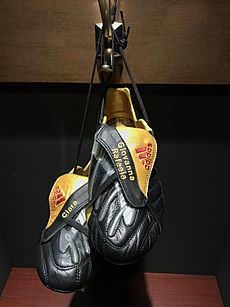
Adidas has sponsored many famous players. These include Lionel Messi, Zinedine Zidane, David Beckham, Paul Pogba, Luis Suárez, and Mohamed Salah.
Adidas is one of the official sponsors of the UEFA Champions League. The Adidas Finale is the official match ball for this competition. Adidas also makes the adiPure line of football boots. Adidas provides clothes and equipment for all teams in Major League Soccer (MLS).
In July 2014, Adidas and Manchester United agreed to a ten-year kit deal. This started with the 2015–16 Premier League season. This deal was worth at least £750 million (US$1.29 billion). This made it the most valuable kit deal in sports history. It replaced Nike as the club's global equipment partner.

In November 2009, tennis player Andy Murray signed a five-year contract with Adidas. It was reportedly worth US$24.5 million. Adidas also sponsors the ball-boy and ball-girl uniforms at the ATP Tennis Tournament in Cincinnati.
Adidas has sponsored many basketball players. These include Kareem Abdul-Jabbar (the first NBA player to sign with Adidas), Tim Duncan, Tracy McGrady, and current players like James Harden, Damian Lillard, Donovan Mitchell, and Derrick Rose. Adidas also sponsored Kobe Bryant with his first signature shoe, the Adidas Equipment KB8, until 2002. In August 2015, James Harden left Nike for Adidas. He signed a 13-year contract reportedly worth US$200 million.
In rugby union, Adidas is the current kit supplier for the All Blacks, the France national team, and the Italian national rugby team. Adidas also supplies clothing to all Super Rugby teams until 2022. Adidas is also the official match ball supplier for the Heineken Cup.
Adidas provides field hockey equipment. It sponsors many players from Germany, England, Netherlands, Australia, Spain, and Belgium. The company has been the kit provider for the Argentine women's and men's teams for over 15 years.
Adidas also sponsors professional golfers. These include Collin Morikawa, Ludvig Åberg, and Nick Dunlap. Since Adidas does not make golf equipment, these sponsorships are mainly for clothing and shoes.
In ice hockey, Adidas signed a deal with the National Hockey League (NHL). They became the official uniform and licensed apparel outfitter. This started in the 2017–18 season and lasted through the 2023–24 season.
Adidas's cricket sponsorships include cricketers Lasith Malinga and Kieron Pollard. Adidas's volleyball sponsorships include Ivan Zaytsev and Earvin N'Gapeth.
Images for kids
See also
 In Spanish: Adidas para niños
In Spanish: Adidas para niños


